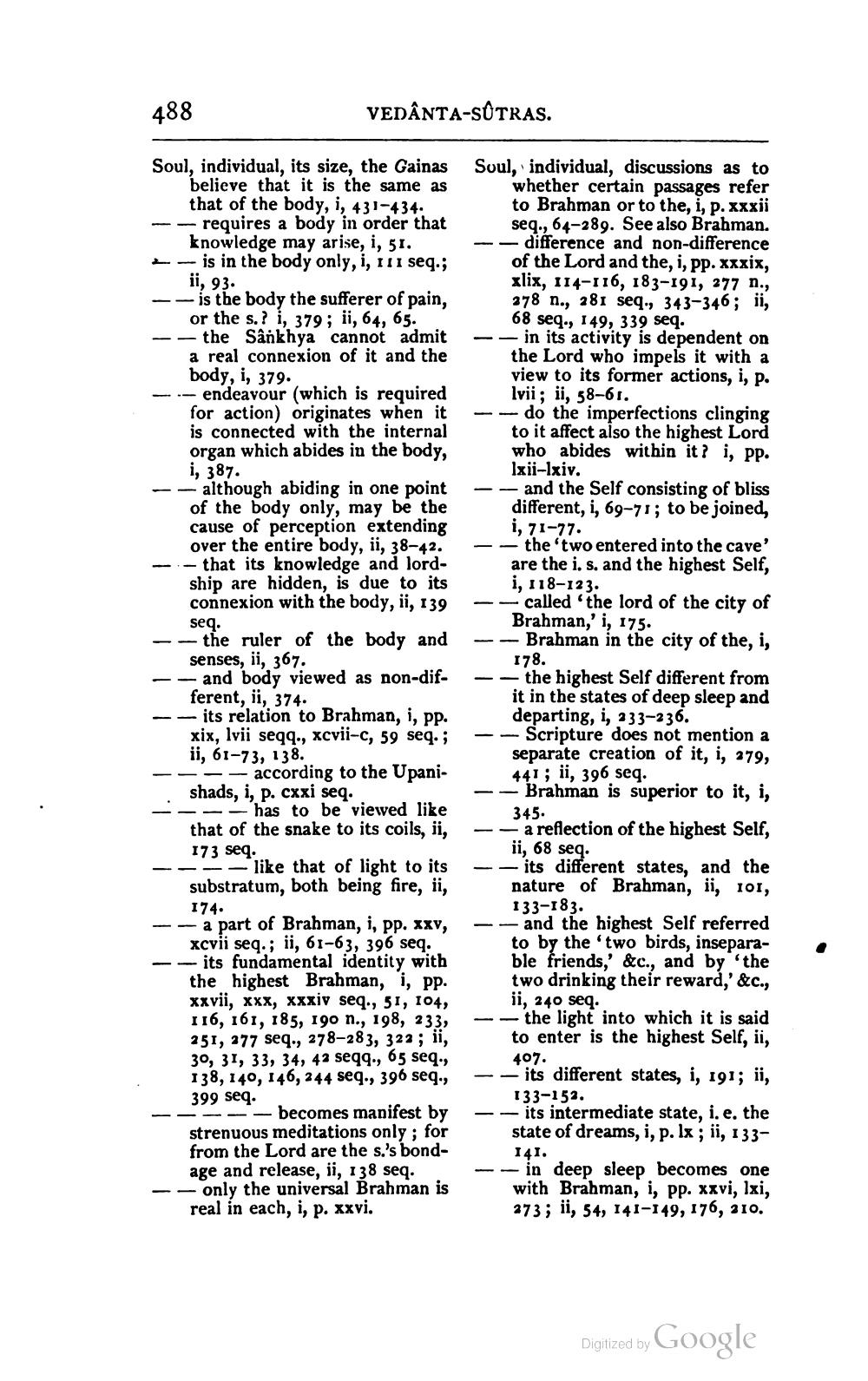________________
488
VEDÂNTA-SÛTRAS.
Soul, individual, its size, the Gainas
believe that it is the same as
that of the body, i, 431-434. - - requires a body in order that
knowledge may arise, i, 51. - is in the body only, i, 111 seq.;
ii, 93 -- is the body the sufferer of pain,
or the s.? i, 379; ii, 64, 65. - the Sankhya cannot admit a real connexion of it and the
body, i, 379. - - endeavour (which is required
for action) originates when it is connected with the internal organ which abides in the body, i, 387. - although abiding in one point of the body only, may be the cause of perception extending
over the entire body, ii, 38-42. - - that its knowledge and lord
ship are hidden, is due to its connexion with the body, ii, 139
Soul, individual, discussions as to
whether certain passages refer to Brahman or to the, i, p. xxxii
seq., 64–289. See also Brahman. -- difference and non-difference
of the Lord and the, i, pp. xxxix, xlix, 114-116, 183-191, 277 n., 378 n., 281 seq., 343-346; ii, 68 seq., 149, 339 seq. - in its activity is dependent on the Lord who impels it with a view to its former actions, i, p.
lvii; ii, 58-61. --do the imperfections clinging
to it affect also the highest Lord who abides within it? i, pp.
Ixii-Ixiv. -- and the Self consisting of bliss
different, i, 69-71; to be joined, i, 71-77. - the two entered into the cave' are the i. s. and the highest Self,
i, 118-123. --called 'the lord of the city of
Brahman,'i, 175. -- Brahman in the city of the, i,
178. - the highest Self different from it in the states of deep sleep and departing, i, 233-236. - Scripture does not mention a separate creation of it, i, 279, 441; ii, 396 seg. - Brahman is superior to it, i,
seq.
345.
-- the ruler of the body and
senses, ii, 367. -- and body viewed as non-dif
ferent, ii, 374. - - its relation to Brahman, i, pp.
xix, lvii seqq., xcvii-c, 59 seq. ; ii, 61-73, 138. --- according to the Upanishads, i, p. cxxi seq.
-- has to be viewed like that of the snake to its coils, ii, 173 seq. - - - like that of light to its substratum, both being fire, ii,
174. -- a part of Brahman, i, pp. xxv,
xcvii seq.; ii, 61-63, 396 seq. - its fundamental identity with the highest Brahman, i, pp. xxvii, xxx, xxxiv seq., 51, 104, 116, 161, 185, 190 n., 198, 233, 251, 277 seq., 278-283, 322; ii, 30, 31, 33, 34, 42 seqq., 65 seq., 138,140, 146, 244 seq., 396 seq., 399 seq.
--- becomes manifest by strenuous meditations only; for from the Lord are the s.'s bondage and release, ii, 138 seq. - only the universal Brahman is real in each, i, p. xxvi.
- a reflection of the highest Self,
ii, 68 seq. - - its different states, and the
nature of Brahman, ii, 101,
133-183. -- and the highest Self referred
to by the two birds, inseparable friends,' &c., and by the two drinking their reward,' &c.,
ii, 240 seq. - - the light into which it is said
to enter is the highest Self, ii,
407. -- its different states, i, 191; ii,
133-152. - - its intermediate state, i.e. the
state of dreams, i, p. lx; ii, 133141. - in deep sleep becomes one with Brahman, i, pp. xxvi, Ixi, 273; ii, 54, 141-149, 176, 310.
Digitized by
Digized by Google




